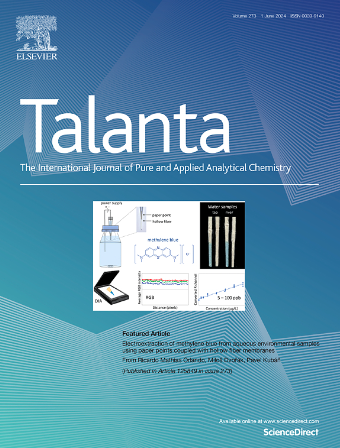Efficient extraction and analysis method for lead-containing nanoparticles in complex biological samples to eliminate “false” interferences by using SP-ICP-MS
IF 5.6
1区 化学
Q1 CHEMISTRY, ANALYTICAL
引用次数: 0
Abstract
Metal-containing nanoparticles (MNPs) ubiquitously exist in the environment and organisms, playing distinct roles in the fate and toxicity of metals. However, the extraction and analysis of the MNPs in biological samples is still a great challenge and the interferences of other metal species and complex matrices remains unclear. In this work, we established a method for efficient extraction and accurate analysis of MNPs in biological samples to eliminate the interference caused by metal ions and biological matrices based on the alkali extraction and single particle mode inductively coupled plasma mass spectrometry (SP-ICP-MS). Obvious interference signals of lead-containing nanoparticles (PbNPs) were found in various biological matrices (liver, brain, bile, intestine, stomach), causing false positive results or overestimation of PbNPs. Then, a novel strategy using EDTA and ultrasonic during the TMAH extraction process were proposed to successfully eliminate the interferences due to the strong and competitively binding of EDTA to Pb ions, which was identified as ionic signals in SP-ICP-MS and resulted in the elimination of interferences. Finally, this method was successfully applied for the extraction, characterization and quantification of PbNPs in different biological tissues collected near a power plant, revealing the occurrence of PbNPs in stomach, intestine and liver tissues and indicating their oral exposure and potential translocation. This method could be universally applied for the efficient extraction and accurate analysis of MNPs in biological samples and thus provided a reliable and powerful tool for the investigation of the occurrence, fate and toxicity of MNPs in environmental and organisms.

采用SP-ICP-MS对复杂生物样品中含铅纳米粒子进行高效萃取分析,消除“假”干扰。
含金属纳米颗粒(MNPs)普遍存在于环境和生物体中,在金属的命运和毒性中发挥着独特的作用。然而,生物样品中MNPs的提取和分析仍然是一个巨大的挑战,其他金属物种和复杂基质的干扰尚不清楚。本研究基于碱萃取和单粒子模式电感耦合等离子体质谱(SP-ICP-MS),建立了一种有效提取和准确分析生物样品中MNPs的方法,以消除金属离子和生物基质对MNPs的干扰。在各种生物基质(肝、脑、胆汁、肠、胃)中发现了明显的含铅纳米颗粒(PbNPs)干扰信号,导致PbNPs的假阳性或高估。然后,提出了一种在TMAH提取过程中使用EDTA和超声波的新策略,成功地消除了由于EDTA与Pb离子的强和竞争性结合而产生的干扰,Pb离子在SP-ICP-MS中被识别为离子信号,从而消除了干扰。最后,该方法成功应用于某电厂附近采集的不同生物组织中PbNPs的提取、表征和定量,揭示了PbNPs在胃、肠和肝组织中的存在情况,并提示其经口暴露和潜在易位。该方法可普遍应用于生物样品中MNPs的高效提取和准确分析,为研究MNPs在环境和生物中的发生、命运和毒性提供了可靠而有力的工具。
本文章由计算机程序翻译,如有差异,请以英文原文为准。
求助全文
约1分钟内获得全文
求助全文
来源期刊

Talanta
化学-分析化学
CiteScore
12.30
自引率
4.90%
发文量
861
审稿时长
29 days
期刊介绍:
Talanta provides a forum for the publication of original research papers, short communications, and critical reviews in all branches of pure and applied analytical chemistry. Papers are evaluated based on established guidelines, including the fundamental nature of the study, scientific novelty, substantial improvement or advantage over existing technology or methods, and demonstrated analytical applicability. Original research papers on fundamental studies, and on novel sensor and instrumentation developments, are encouraged. Novel or improved applications in areas such as clinical and biological chemistry, environmental analysis, geochemistry, materials science and engineering, and analytical platforms for omics development are welcome.
Analytical performance of methods should be determined, including interference and matrix effects, and methods should be validated by comparison with a standard method, or analysis of a certified reference material. Simple spiking recoveries may not be sufficient. The developed method should especially comprise information on selectivity, sensitivity, detection limits, accuracy, and reliability. However, applying official validation or robustness studies to a routine method or technique does not necessarily constitute novelty. Proper statistical treatment of the data should be provided. Relevant literature should be cited, including related publications by the authors, and authors should discuss how their proposed methodology compares with previously reported methods.
 求助内容:
求助内容: 应助结果提醒方式:
应助结果提醒方式:


